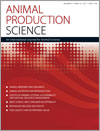
Animal Production Science
Volume 51 Number 12 2011
AN10162 Nutrition × reproduction interaction in pasture-based systems: is nutrition a factor in reproductive failure?
Nutrition has been implicated in reproductive failure in pasture-based dairy herds, where condition score at key times, irregular feed supply and variable, as well as suboptimal, feed composition have all been highlighted as possible reasons. The conclusions from a comprehensive review suggest that condition score at calving and in early lactation is an important variable in reproductive success, but that the effect of diet composition and feed supply is complex and will not be corrected through simple supplementation strategies.
AN11112Estimating the transfer of contaminants in animal feedstuffs to livestock tissues, milk and eggs: a review
Knowledge of contaminants present in animal feeds that can transfer to foods such as meat, milk and eggs is important for the protection of public health. This paper presents transfer factors that allow estimates of levels in food to be made based on levels present in feed. The information will be useful in refining systems for the production of safe livestock feeds.
AN11129 Companion cropping chicory with winter forage cereals for grazing and forage conservation. Dry matter yields, nutritive characteristics and mineral content
Increasing the amount of forage grown and harvested on dairy farms is strongly linked to farm profitability. Current forage systems on dryland dairy farms are highly seasonal in dry matter production and options that provide a more even supply of forage are desirable. This study highlighted the potential of combining chicory and forage cereals to increase dry matter production and also produce feed at times when the current system fails to do so.
AN11044 Adaptation behaviour of local and rangeland cattle relocated to a temperate agricultural pasture
Beef producers may move young cattle between pastures during the year to help ensure an adequate supply of feed. After they are moved the animals may take some time to learn and adapt to eating the new feeds and the efficiency of the grazing system may be reduced. In this study we found that young cattle that are transferred from the rangelands to agricultural pastures take 4–6 weeks to adjust their grazing behaviour and resume normal growth, which may reduce the utilisation of the new pastures.
AN11143 Fluctuations in the concentration of ergovaline and lolitrem B produced by the wild-type endophyte (Neotyphodium lolii) in perennial ryegrass (Lolium perenne) pasture
The toxic alkaloids, ergovaline and lolitrem B (a neurotoxin) produced by a fungal endophyte in perennial ryegrass cause production losses in livestock. Over November to April, the concentration of ergovaline in wild-type, endophyte-infected perennial ryegrass peaked in early summer, declined as temperature increased, then peaked again with the commencement of autumn growth. Ergovaline frequently exceeded the livestock tolerance level but high concentrations of lolitrem B were observed only if conditions favoured growth or where pasture was kept close-grazed.
AN11035 Effect of dietary consumption of sheep meat on thyroid hormone levels and energy expenditure of Sprague–Dawley rats
Many Eastern cultures believe that consumption of certain foods by humans has an effect on energy expenditure, but there is no clear evidence to support such claims. Using a rat model system we found that consumption of sheep meat (compared with an isocaloric diet) stimulated increased production of a thyroid hormone, which, over time, reduced both bodyweight and bodyweight gain. These findings might have important implications for the role of meat in the regulation of bodyweight.
AN11125 Nutritive value of corn silage in mixture with vine peas
Combining corn with legumes for silage is a feasible strategy to improve crude protein concentration in corn silage. The present study aimed to determine fermentation characteristics and overall nutritive value of ensiled corn (Zea mays L.) and vine peas (Pisum sativum L.) at different ratios, and combining vine peas with corn for silage at a ratio of 33 : 67 could improve fermentation characteristics of ensiled forage with high energy and crude protein concentrations. This silage could reduce protein concentrate in dairy cow ration, and therefore feed costs.
AN11091 Effect of different levels of amino acids on carcass composition and yield in broilers
The concentration of protein and amino acids in broiler diets has a large impact on breast meat yield, feed : gain ratio, and on the number of days required to produce the appropriate bodyweight for each type of market. Additional amino acids in starter and grower diets optimised bodyweight gain in Arian broilers, whereas reductions in amino acid levels reduced growth and liveweight.
AN11059 Significance of phenolic compounds in tropical forages for the ruminal bypass of polyunsaturated fatty acids and the appearance of biohydrogenation intermediates as examined in vitro
The study showed in vitro that protection of linolenic acid from hydrogenation in the rumen depends on the concentrations of phenols in the feed. Evidence is also shown for an increased accumulation of vaccenic acid and conjugated linoleic acid in the rumen when using plants with higher phenolic contents. In sum, an increased phenolic content of forages may increase beneficial fatty acids reaching the duodenum and, finally, the milk or the muscle tissue, thus enhancing nutritional quality of these products.



